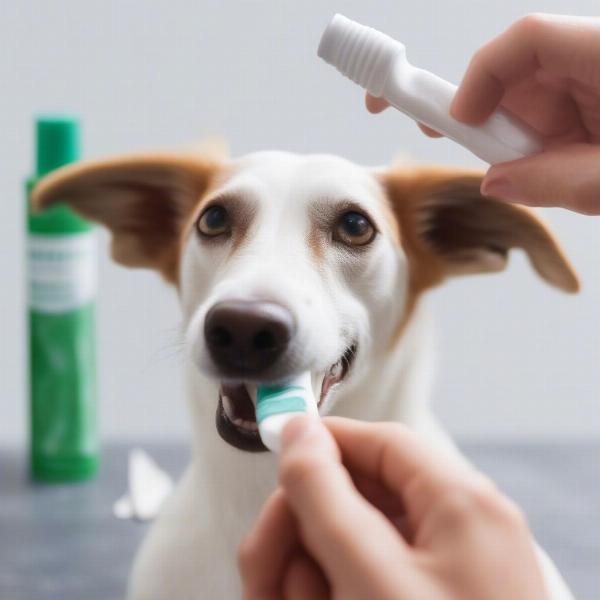Enzymes are a key ingredient in many dog toothpastes, offering significant benefits for canine oral health. But what exactly are these enzymes, and how do they work? This guide will delve into the world of dog toothpaste with enzymes, exploring their benefits, how to choose the right one, and how to use it effectively.
Understanding the Power of Enzymes in Dog Toothpaste
 Close-up of dog toothpaste with enzymes being applied to a toothbrush
Close-up of dog toothpaste with enzymes being applied to a toothbrush
Enzymes in dog toothpaste work by breaking down proteins found in plaque and tartar, helping to prevent their buildup on your dog’s teeth. These proteins act as a “glue” that binds bacteria together, forming the sticky film we know as plaque. By dissolving these proteins, enzymatic toothpaste helps loosen and remove plaque, promoting cleaner teeth and fresher breath. This process is particularly important because plaque, if left unchecked, can harden into tartar, which can only be removed by a professional dental cleaning.
Choosing the Right Enzymatic Toothpaste for Your Dog
With so many options available, selecting the right dog toothpaste with enzymes can seem overwhelming. Look for toothpastes that contain beneficial enzymes like glucose oxidase, lactoperoxidase, and lysozyme. These enzymes are particularly effective at breaking down plaque and neutralizing bad breath. Avoid human toothpaste, which often contains ingredients like xylitol that are toxic to dogs. Instead, opt for a toothpaste specifically formulated for canine use. Consider your dog’s preferences when choosing a flavor. Poultry, beef, and peanut butter are popular choices that can make brushing more enjoyable for your furry friend. You can also find brushless toothpaste for dogs if your dog resists traditional brushing. Learn more about different options in our article on brushless toothpaste for dogs.
Brushing Techniques and Tips for Effective Cleaning
Even the best dog toothpaste with enzymes won’t be effective if not used correctly. Start by introducing the toothpaste gradually, letting your dog lick a small amount to get used to the taste. Use a soft-bristled toothbrush designed for dogs, or a finger brush for easier access. Gently brush in a circular motion, focusing on the gum line where plaque tends to accumulate. Aim to brush your dog’s teeth daily, but even a few times a week can make a difference. For a deeper understanding of canine oral hygiene, check out our guide on how dirty is a dog’s mouth. Combine brushing with other dental care practices, such as dental chews and regular checkups, for comprehensive oral health. Explore our review of check up dental chews for dogs for more insights.
Beyond Brushing: Other Dental Care Practices
Maintaining your dog’s oral health goes beyond just brushing with enzymatic toothpaste. Dental chews and toys can help mechanically remove plaque and tartar. Regular veterinary checkups are crucial for professional cleaning and identifying any potential dental problems early on. A good plaque remover can be a valuable addition to your dog’s dental care routine. You can learn more about effective plaque removers in our article on plaque remover for dogs.
Conclusion
Dog toothpaste with enzymes is a powerful tool for maintaining your dog’s oral health. By breaking down plaque and preventing tartar buildup, these toothpastes contribute to fresher breath, healthier gums, and overall well-being. Choosing the right toothpaste, using proper brushing techniques, and incorporating other dental care practices will ensure your furry friend enjoys a happy and healthy smile for years to come. Remember to consult with your veterinarian for personalized advice and to address any specific dental concerns. Find out more about a popular option, Petsmile dog toothpaste, for additional information.
FAQ
- Are all dog toothpastes with enzymes safe? Always choose a toothpaste specifically formulated for dogs and avoid human toothpaste, which can contain toxic ingredients.
- How often should I brush my dog’s teeth with enzymatic toothpaste? Ideally, daily brushing is recommended, but even a few times a week can be beneficial.
- Can I use enzymatic toothpaste on puppies? Yes, you can start using enzymatic toothpaste on puppies as soon as their teeth erupt.
- What are the signs of dental problems in dogs? Bad breath, red or swollen gums, difficulty eating, and excessive drooling can be indicators of dental issues.
- Is enzymatic toothpaste enough to prevent tartar? While enzymatic toothpaste helps prevent tartar buildup, regular veterinary cleanings and other dental care practices are also important.
- What if my dog doesn’t like the taste of enzymatic toothpaste? Try different flavors to find one your dog enjoys. You can also gradually introduce the toothpaste to get them used to the taste.
- Are there any alternatives to brushing if my dog resists? Yes, dental chews, treats, and water additives can help maintain oral hygiene, but they are not as effective as brushing.
ILM Dog is your trusted resource for expert advice on all aspects of dog care, from breed selection and health to training, nutrition, and grooming. We offer a wealth of information and resources to help you provide the best possible care for your canine companion. Whether you’re a new dog owner or a seasoned expert, ILM Dog has the knowledge and tools you need to navigate the world of dog ownership. Contact us at [email protected] or +44 20-3965-8624 for personalized guidance and support.